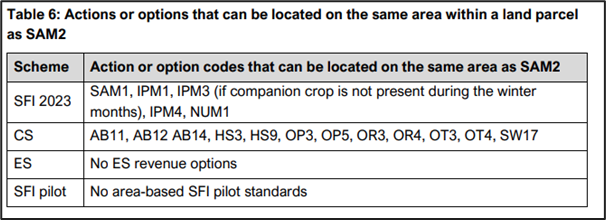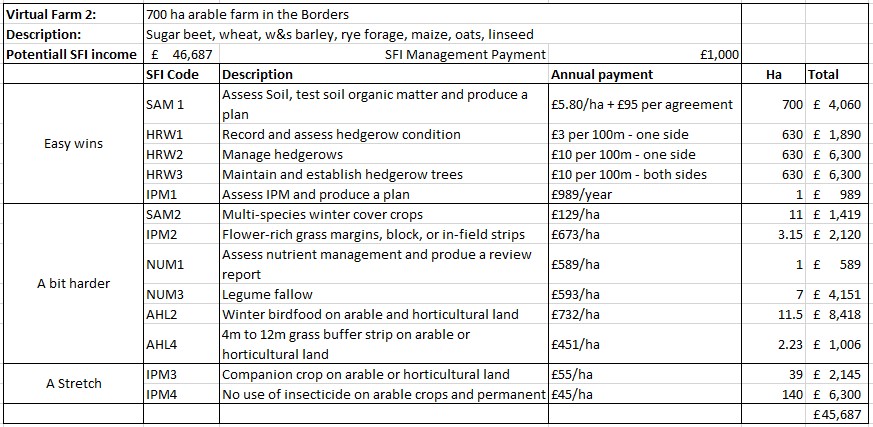Home > AF guide to SFI 2023
AF guide to SFI 2023
Getting the SFI vibe
AF has reviewed the DEFRA handbook for the 2023 SFI offer which was published in August to assist farmers and advisers. Last Friday, 6th October, we also joined Members and other farmers at a FWAG SFI workshop, where Nathan Walker led a very helpful session.
What are the basics?
SFI pays farmers to adopt and maintain sustainable farming practices that can protect and improve the environment. Access to the SFI application website is being staggered, and when you are invited you will apply for a 3 year SFI agreement, to carry out agreed and costed ‘actions’. Actions and land can be added at each anniversary.
The new SFI contains 23 actions for:
- Soils
- Moorland
- Hedgerows
- Integrated pest management (IPM)
- Nutrient management
- Farmland wildlife on arable and horticultural land
- Farmland wildlife on improved grassland
- Buffer strips
- Low input grassland
Each group contains between one and four actions, and the handbook, linked above, details what they are and importantly how much each is worth.
Choices! Choices!
The temptation is to look at the actions summary on pages 9 & 10 of the handbook and select the most lucrative!
The highest payment is to plant winter bird food on arable or horticultural land £732/ha, then planting flower rich margins, blocks and strips for IPM £673/ha, then planting pollen and nectar flower mix £614/ha – down to assessing and producing an IPM plan for a flat fee of £989/yr or assessing and recording hedgerow condition for £3 per 100m (one side).
Of course, it may also be appealing to include actions which are already part of farm practice – managing hedgerows for £10/100m (one side) or planting multi species cover crops £129/ha. Maybe 4m-12m grass buffer strips on arable land £451/ha.
There is also an allowance of £20/ha up to 50 ha as an SFI management payment, so £1,000 per SBI just for completing your application!
How will SFIs affect Countryside Stewardship (CS) and Environmental Stewardship (ES) schemes?
You are allowed to enter land into an SFI that is used for other government schemes and funding, if you and your land are eligible for both schemes. The activities or outcomes must be compatible, and you must not be paid twice for the same or similar activity. But for example, if you have a four-hectare field with 2ha planted with herbal ley under CS, you can plant the other 2 ha with herbal ley under SFI, as long as you can show that the areas are not double counted.
The rules for individual schemes are fairly simple, and again clearly explained in the handbook at page 114.
The handbook provides a very handy table for each SFI action showing actions from other schemes that can be located on the same area, found on pages 18-100 where the actions are described e.g.:

Making the most of SFI
AF has produced some virtual farm businesses below, and suggested options of SFI actions which may be suitable. Suggestions are grouped into easy wins, which require little adjustment or may even be common practice at the moment. Also suggestions of actions which are ‘a bit harder’, may require adjustments to rotations or a change of approach. Finally we cover ‘stretch’ options – actions which are a bit harder, and may not pay so well, but show a commitment to sustainability.
We have created examples of a mixed arable and dairy enterprise in East Anglia, an arable farm in the Borders and a mixed beef/sheep/arable farm in South West England.




If you are raising your eyebrows and reaching for a bottle thinking that your SFI payments are going to be much less than BPS, remember that SFI is only part of the package of support available. There are additional funds available for improving water quality, reducing flood risk, farming in protected areas, protecting animal health and welfare, creating woodlands, equipment and technology, as well as the Farming Resilience Fund.
And finally…
AF hears from Members that the SFI application process via the RPA portal is simple, and can be quick! The system is still quite prone to errors, and the error messages can be hard to navigate, but we are told that so far the RPA advisers have been very helpful. Good luck!



